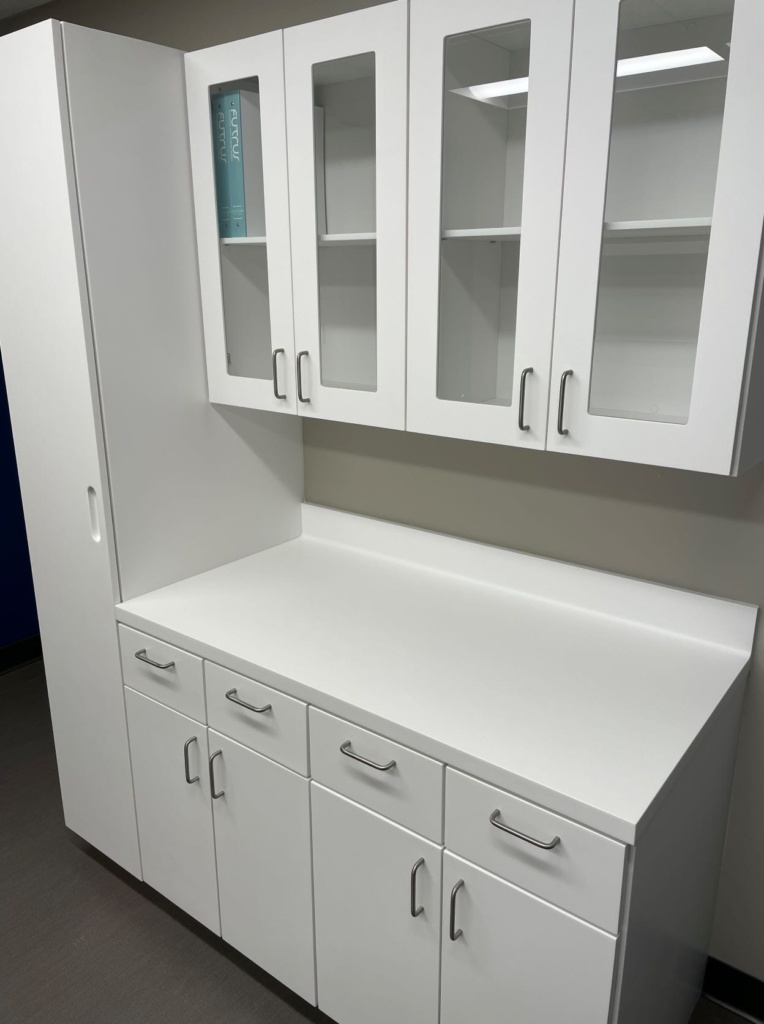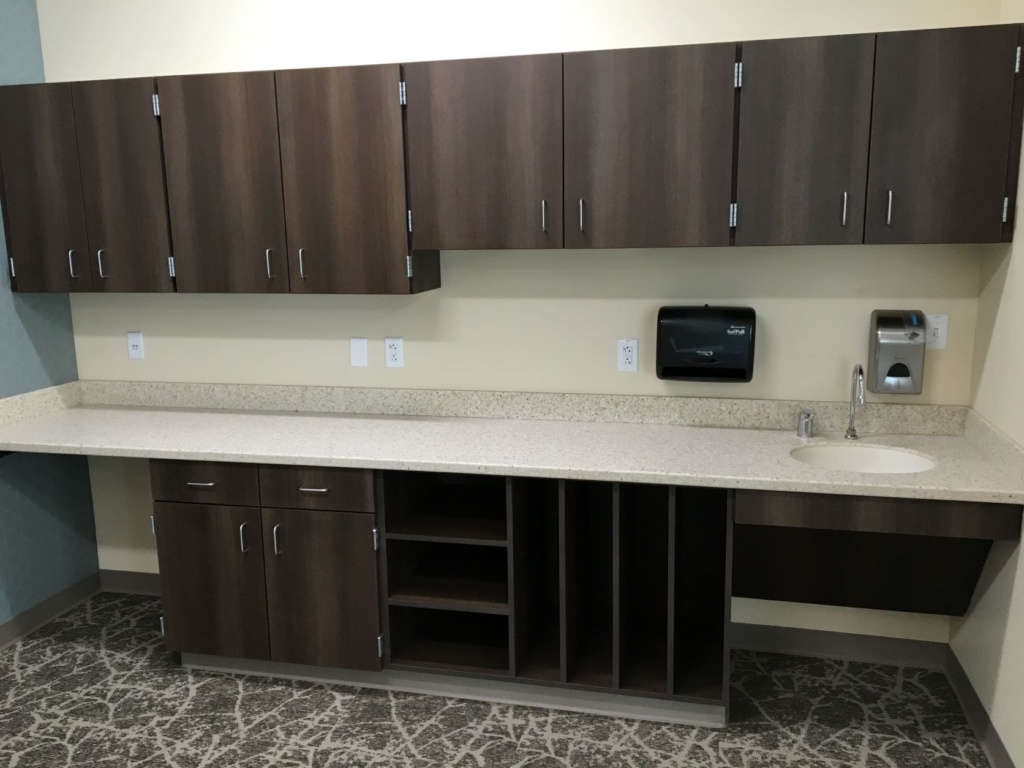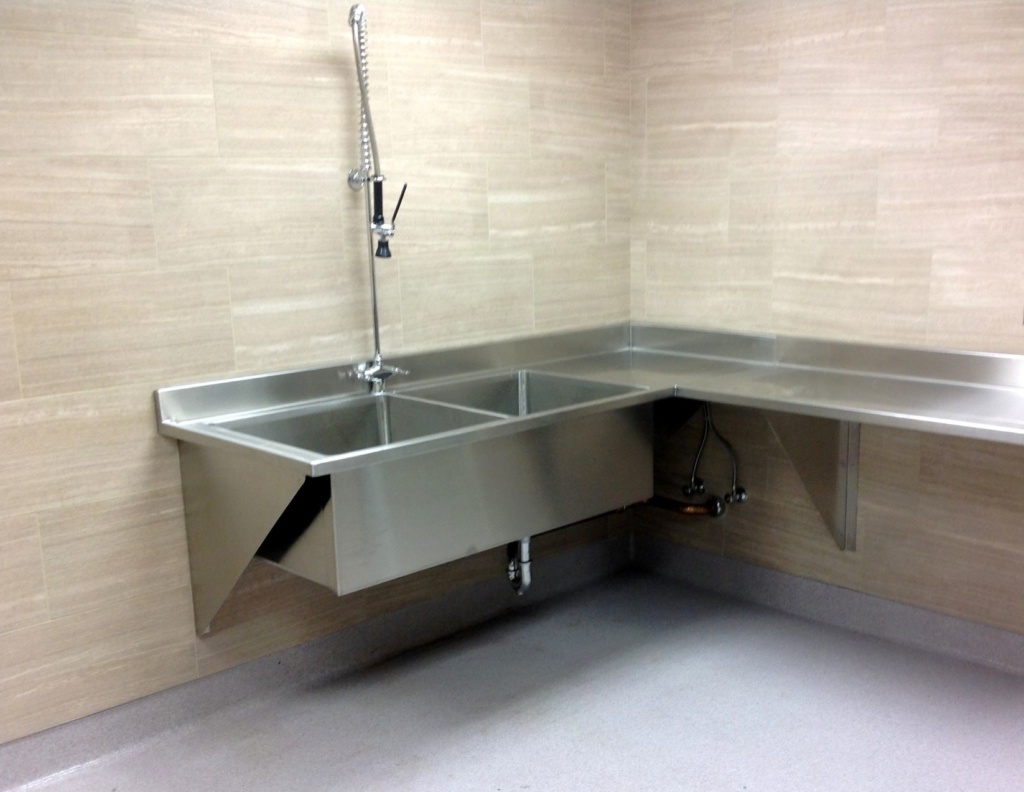
Countertops In Healthcare Environments
Choosing the right countertop is a serious consideration for healthcare environments. The main considerations when choosing a healthcare countertop are the sanitization, cleanability, durability, aesthetic and long-term value for the facility.
In a healthcare setting, you’re worried about the material itself, but also the system into which it is incorporated. This means the most resilient materials are irrelevant if they don’t integrate well into the environment. For instance, stainless steel is durable and impervious to moisture, but it is also cold and loud and scratches, which makes it ill-suited to patient rooms. Conversely, plastic laminate is durable and cost-effective, but has seams and a wood core which are liable to harbor mold and bacteria, making it a poor choice for an operating room. These issues may not be apparent at first, but over time become a serious problem.
Healthcare sanitization focuses most intensely around the patient. Hospital beds and the head wall components, as well as the over-bed table and the side tables are the most important areas for infection control.
The second most important area is the wash-up sink that all of the nurses, doctors, and staff use as they enter and exit a room. Other high contamination touch-points include places where soiled linens or trash are stored.
These areas must be highly sanitized and great care must be given to the cleanability and durability of these surfaces. When it comes to healthcare countertops, sanitization, longevity and aesthetics are the most important concerns.
“Value” is a common topic when choosing countertop materials. It’s important to understand that value is a combination of all three of the above mentioned criteria: sanitization, longevity and aesthetics. These three elements work together for several reasons.
Healthcare outcomes are impacted by things like the aesthetics of the hospital environment, as well as the cleanliness. When there is competition in healthcare, patients are not inclined to a cold, clinical environment; they want a safe and comfortable place to heal. In addition, the cost of one hospital acquired infection (HAI)can completely erase any savings in material cost at construction. Value, therefore, takes into account a variety of factors.
In this guide, we will be covering the most widely used countertop materials in healthcare settings and providing the best use cases as well as pros and cons.
Laminate

For decades, plastic laminate (like Formica®) was the most popular healthcare countertop product. However, in the era of infection control and rigid sanitization processes, it has failed the test of time. Laminate is an affordable and durable material, but in most situations it will deteriorate, at least at an aesthetic level, with the use of bleach-based disinfectants.
Hospital-acquired infections have become more of a concern to hospitals in recent years. Disinfectant protocols have evolved to help mitigate them. Because laminate countertops have limited sheet sizes and wood-based particleboard cores, they have joints which create potential vulnerabilities at the edges or seams of the countertop.
Where moisture is present bacteria and mold can survive and grow. Additionally, there is always some kind of joint or seam at sink locations when using laminate countertops. These joints and seams can never be cleaned perfectly and provide a “safe harbor” for bacteria or viruses.
Laminate countertops also cause frustration for facilities staff because laminate end-splashes and often back-splashes require a caulk joint at the work surface. This caulk deteriorates, discolors, and changes properties by shrinking or hardening over time. This is an eye-sore at best and a disinfectant nightmare at worst.
The best place to use laminate in a healthcare settings is anywhere that sanitization and bacteria are not the chief concern, and where moisture is not present: charting activities or support spaces, for example.
Pros:
- The most affordable countertop material.
- Can be fabricated with limited carpentry experience.
- Provides a uniform aesthetic.
- Good durability and abrasion resistance under normal use
Cons:
- Bleach cleaners will damage the surface.
- Seams and joints harbor bacteria and mold.
- Wood cores are susceptible to moisture.
- Edges can be sharp
- Bruce’s notes
Solid Surface

Solid surface was first introduced by DuPont in 1967. They called it Corian®. Today, there are many manufacturers of solid surface countertops, but Corian® remains a household name in residential, commercial and institutional countertop applications.
Solid surface countertops are noteworthy for a number of reasons and these reasons lend themselves particularly to a healthcare environment.
First, solid surface countertops are non-porous. This means they cannot absorb liquids, making them stain-resistant, waterproof and strongly resistant to harsh cleaners, such as bleach. In addition, Dupont™ Corian® does not support microbial growth when properly cleaned. “Corian® has been listed by GreenGuard for being microbally tested according to a test method following the guidelines of ASTM D 6329 and analyzed with a quantitative scale.” This is of special significance in an age where hospital acquired infections (HAI’s) directly impact hospital medicare/medicaid reimbursements and patient satisfaction ratings.
Solid surface provides the ability to design and create seamless work surfaces, making it even harder for bacteria to hide and easier to keep countertops sanitized. Because solid surface countertops have inherent structural properties, they do not need a particle board core or continuous plywood support. For this reason, the edges of the countertop can have an integral and seamless construction and aesthetic.
Backsplashes and end splashes can be separate pieces that are adhered to the work-surface at the time of installation (this is a great option for construction where walls are uneven and framing is inconsistent). Because there is no wood core, even if there are gaps in the joint over time, there’s no exposure to wood that can foment bacteria. This is an advantage over a laminate countertop.
Finally, even when seams are unavoidable, for installation or configuration purposes, solid surface countertop sections can be glued together using the same material as the countertop itself. These seams are almost invisible and contribute to the sanitary properties of the countertop system as a whole.
Pros:
- Anti-microbial surface.
- Resistant to chemicals. Bleach cleanable.
- Seamless construction.
- Impervious to moisture.
- Repairable if damaged by abuse.
- Aesthetically pleasing.
- Wide variety of color options and finishes.
Cons:
- Susceptible to scratches.
- Not resistant to heat.
- Can be damaged by exposure to acids (so not for most lab use).
Quartz

Quartz countertops, or sometimes classified as engineered stone, are fabricated by mixing natural stone elements with binding resins. These castings create a product that mimics the look of marble or granite, but delivers a uniform and more durable commercial surface. The quartz stone itself is one of the most common minerals found on earth and one of the hardest, making it an ideal candidate for creating compound stone.
Quartz has taken an increasing share of healthcare countertops over the last decade. This widespread adoption is driven by the market availability, improved aesthetic design, and consistency of quartz countertops, combined with hospitals’ ever-increasing focus on creating beautiful and durable spaces.
In a healthcare setting, quartz has many beneficial qualities. Because quartz countertops are made by pressing quartz into polymer resins, quartz has a non-porous quality to it that isn’t found in other stone countertop materials. Similar to solid-surface, when liquids are spilled on quartz, they are not absorbed. This makes quartz countertops resistant to bacteria and staining. They are also easy to clean, even with harsher hospital cleaning agents.
Because quartz is such a hard material, quartz countertops are highly resistant to scratches and are easy to care for and maintain. Quartz’s durability allows it to last for years, even in high-traffic or abusive environments.
Pros:
- Durable and long-lasting.
- Resistant to stains, chemicals, and scratching.
- Aesthetically consistent and visually pleasing, they bring the look of natural stone into the built environment.
- Structural properties allow designers to create architectural statement pieces.
- Do not have the fault lines or inherent weakness of natural stone slabs.
Cons:
- Can be more expensive compared to other material options.
- Product weight requires special installation procedures.
- Cannot be bent or thermoformed to cover curved surfaces.
Stainless Steel

Stainless steel’s innovation and rise to market prominence was forged out of necessity around the turn of the 20th century as industrialists sought to find metal products that could avoid pitting & corrosion and boast improved properties of heat resistance and higher tensile strength. In the modern healthcare environment, stainless steel is ubiquitous—from the entry door to the operating room.
Stainless steel has many advantages that make it well-suited for countertops in the hospital setting. Most notably, stainless steel is easy to clean and can withstand the harsh chemicals used around it. Like other materials on this list, stainless steel is non-porous so it resists staining and will not absorb spills or foster bacterial growth.
Stainless steel is highly heat resistant, but over time will become scratched. These random abrasions or deeper gouges will dull the finish appearance and reduce the aesthetic appeal of the material.
Stainless tops are particularly useful at utility stations, especially soiled linen and decontamination stations in “support areas.”
Pros:
- Rust-proof and corrosion resistant.
- Highly heat-resistant.
- Anti-bacterial properties.
- Chemical resistant and easy to clean.
- Can be custom fabricated to nearly any configuration
- Almost infinite recyclability makes it the most sustainable product
Cons:
- Scratches easily.
- Loses aesthetic quality over time.
- Higher cost compared to other surfaces.
- Accentuates loud noises, making them disruptive to healing spaces.
Picking The Right Healthcare Countertop
When it comes to the healthcare environment, the use and context of the countertop should be the driving factor. The cost of things like hospital re-admissions and HAI’s make the right choice of countertop an important one. Choosing countertop materials based only on price can result in much higher costs down the road.
Using this guide will help you to determine the best material, depending on environment and use, in your hospital or healthcare setting.